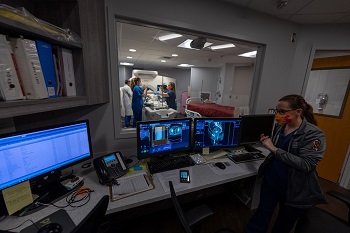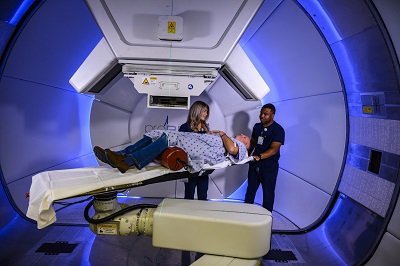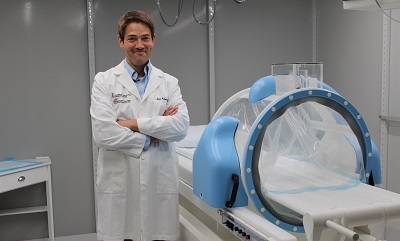State-of-the-Art Technology
 The Department of Radiation Oncology at the University of Maryland is strongly committed to maintaining the quality of our educational program. Our department is at the forefront of innovation with its nationally recognized Medical Physics and Radiobiology divisions, which provide outstanding clinical and research experiences for trainees.
The Department of Radiation Oncology at the University of Maryland is strongly committed to maintaining the quality of our educational program. Our department is at the forefront of innovation with its nationally recognized Medical Physics and Radiobiology divisions, which provide outstanding clinical and research experiences for trainees.
As clinical trainees, you will have the opportunity to train in a diverse array of technologies which include, but are not limited to:
- External Beam Radiation Therapy
- External Beam with 12 Varian Linear Accelerators including the TrueBeam Edge, TrueBeam, and Trilogy
- 3DCRT/IMRT/VMAT
- RapidArc
- Stereotactic Body Radiation Therapy (SBRT)
- Stereotactic Radiosurgery (SRS): A dedicated TrueBeam Edge system that reaches submillimeter accuracy level including flattening filter-free (FFF) photon beam, HD-MLC, 6D couch, and optical surface monitoring system (OSMS)
- Low-dose rate (LDR) Brachytherapy
- Radioactive iodine (I-125) seed implantation for prostate cancer
- Radioembolization or Selective Internal Radiation Therapy (SIRT) for liver tumors with SIR-Spheres Y-90
- High-dose rate (HDR) Brachytherapy
- State-of-are equipment: two Elekta Flexitron afterloaders and one Varian Bravos afterloader
- Intracavitary treatment of Gynecologic cancer with vaginal cylinder, Tandem & Ring, and Tandem & Ovoid applicators
- Interstitial treatment of Gynecologic cancer with Venezia applicator or needles with Syed templates
- HDR brachytherapy for prostate cancer
- HDR brachytherapy for skin cancer
- SAVI treatment for breast cancer
- Radionuclide Therapy
- Xofigo® therapy treatment (radioactive radium Ra-223 dichloride) IV treatment for prostate cancer metastatic to bones
- PLUVICTO® (lutetium Lu 177 vipivotide tetraxetan) IV or infusion treatment for certain advanced metastatic prostate cancers
- Hyperthermia Therapy
- Deep Hyperthermia Therapy with BSD-2000 Deep Regional Hyperthermia System
- External Hyperthermia Therapy with BSD-500 Microwave Hyperthemia System
- Interstitial Hyperthermia Therapy with BSD-500 Microwave Hyperthemia System
- Respiratory Monitoring and Motion Management
- Breath-hold treatment with Vision RT system for breast cancer patients
- Breath-hold treatment with SDX breath monitoring system for thoracic and abdominal cancer treatment
- Abdominal compression with a belt in reducing the respiratory tumor motion for thoracic and abdominal cancer treatment
- Proton Therapy
- Varian ProBeam Pencil Beam Scanning System with 4 rotational gantry rooms and 1 fixed gantry room
- Image-guided proton therapy with on-board imaging (OBI) system, CBCT, and Vision RT
- 6D robotic couch
- Image Guided Radiation Therapy (IGRT)
- MV Portal Imaging
- OBI/CBCT
- Vision RT System/ AlignRT
- Imaging System for Treatment Planning
- Six CT scanners with 4DCT capability
- A Dual energy CT scanner
- A MRI scanner
- Advanced Treatment Planning System (TPS)
- RayStation TPS from RaySearch Laboratories
- Eclipse TPS from Varian
- Oncentra Brachytherapy TPS from Elekta
- VariSeed TPS for prostate seed implant from Varian
- GammaPod Treatment Unit: A dedicated device for early-stage breast cancer
- Gamma Knife Radiosurgery: Leksell Gamma Knife Perfexion from Elekta, a dedicated intra-cranial SRS treatment Unit
- GRID Radiation Therapy
- Single-fraction high dose (10-20 Gy) delivered to bulky malignant tumor
- GRID therapy with photon beam
- GRID therapy with proton beam
- Lattice radiation therapy (3D GRID)
- Total Body Irradiation (TBI)
- TBI treatment with translational couch
- Tumor Treating Fields (TTF)
More About Select Therapies
The University of Maryland offers the latest in radiation oncology treatments, including a full array of advanced technologies. Learn more below about just a few of our state-of-the-art and unique offerings.
Pencil Beam Scanning Proton Therapy at the Maryland Proton Treatment Center (MPTC)
 The Varian ProBeam® Proton Therapy System at MPTC, one of the most advanced systems in the world
The Varian ProBeam® Proton Therapy System at MPTC, one of the most advanced systems in the world
The Maryland Proton Treatment Center is the first and most experienced proton center in the region. Our center has trained more than 200 medical professionals on the use of proton therapy, including physicians from new and upcoming proton centers in the region.
With proton therapy at the Maryland Proton Treatment Center, patients have a new tool in the cancer-fighting toolbox. MPTC offers the most advanced form of proton therapy in the world – called pencil beam scanning. This technique is highly effective for a wide variety of solid, localized tumors in adults and children.
Since proton therapy delivers an increased dose that stops specifically at the tumor site, it protects much of the surrounding, normal tissue. It’s painless, non-invasive and well tolerated which often times leads to fewer side effects now and in the future.
GammaPod™
The GammaPod™, invented at the University of Maryland
GammaPod™ — the world's first radiation therapy system dedicated specifically to treat early-stage breast cancer — delivers a higher dose of radiation to the tumor and less radiation to nearby vital organs such as the heart and lungs. Using an approach called stereotactic body radiation therapy (SBRT), this innovative technology is also gentler on the skin and healthy breast tissue.
Doctors and scientists at the University of Maryland invented and developed GammaPod™, which the U.S. Food and Drug Administration cleared for use in 2017. The University of Maryland Medical Center was the first in the world to use the new technology to treat patients, and is currently one of the only centers in the world to use GammaPod™.
Deep and Superficial Hyperthermia Therapy 
The Maryland Proton Treatment Center is the only location in the U.S. to house proton therapy and hyperthermia under one roof
Hyperthermia therapy is a non-invasive procedure that heats the tumor to between 104 and 110 degrees Fahrenheit and sensitizes cancer to other therapies. It is used in combination with protons, radiation, and chemotherapy. This treatment offers minimal side effects and when combined with other standard therapies can improve a patient’s odds of beating cancer.
